
Art | Resources
Corky’s Nuts
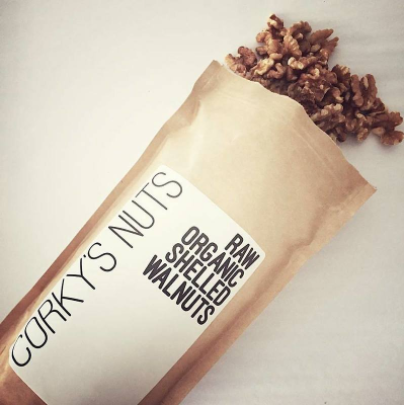 Fresh walnuts and cold-pressed walnut oil from a family-owned family farm in Northern California. “It all began back in 1975 when my parents acquired land in a small, beautiful valley located in Northern California…My “a-ha” moment came the first time I shared our organic walnuts with my husband, Eric. When we first started dating, he so kindly bought a bag of organic walnuts from a popular natural food chain as a thoughtful gesture. I ate one walnut and had to spit it out. It tasted old, dry, and bitter. If you’re reading this, I’m sure you can relate. I had never purchased walnuts from a store because I always had access to fresh ones…it was during this moment I realized, most of the general public does not have access to freshly harvested organic walnuts. That is, unless you know a walnut farmer. Well, now you do…Over the past 35 years, I’ve watched my father tend to his trees and the land as if they were his own children. There’s a lot of love and care which goes into growing our organic walnuts.”
Fresh walnuts and cold-pressed walnut oil from a family-owned family farm in Northern California. “It all began back in 1975 when my parents acquired land in a small, beautiful valley located in Northern California…My “a-ha” moment came the first time I shared our organic walnuts with my husband, Eric. When we first started dating, he so kindly bought a bag of organic walnuts from a popular natural food chain as a thoughtful gesture. I ate one walnut and had to spit it out. It tasted old, dry, and bitter. If you’re reading this, I’m sure you can relate. I had never purchased walnuts from a store because I always had access to fresh ones…it was during this moment I realized, most of the general public does not have access to freshly harvested organic walnuts. That is, unless you know a walnut farmer. Well, now you do…Over the past 35 years, I’ve watched my father tend to his trees and the land as if they were his own children. There’s a lot of love and care which goes into growing our organic walnuts.”
Z Shoes
 OK here we are…”Every Z Shoe starts with a comfortable sole made from 100% organic, fair trade, sustainably-harvested Amazonian Sharinga rubber…No plastic or synthetic fibers here. Z Shoes are made from 100% organic, fair trade sustainably-harvested cotton from the Solo y San Miguel regions of Peru…Even the beautiful coral and navy blue options available in the Z Shoes line up come from 100% organic plant dyes sourced from in the Amazon…Z Shoes is proud to offer the world’s finest line of fair trade and organic shoes. ”
OK here we are…”Every Z Shoe starts with a comfortable sole made from 100% organic, fair trade, sustainably-harvested Amazonian Sharinga rubber…No plastic or synthetic fibers here. Z Shoes are made from 100% organic, fair trade sustainably-harvested cotton from the Solo y San Miguel regions of Peru…Even the beautiful coral and navy blue options available in the Z Shoes line up come from 100% organic plant dyes sourced from in the Amazon…Z Shoes is proud to offer the world’s finest line of fair trade and organic shoes. ”
Eclectic Institute
 Quality herbs and supplements created by a naturopathic physician. “We start and end with whole, raw herbs. We start by growing herbs on our 90 acre certified organic farm, and then use freeze-drying to remove only the water. The end product is the whole herb in its original form still raw, intact, viable, and retaining the benefits of the fresh herb just as Mother Nature intended. We don’t believe in harsher forms of processing such as air or spray drying, chemical extraction, or standardized extracts which alter whole herbs, potentially excluding or destroying active constituents. Nestled at the base of Mt. hood in the pristine Oregon countryside, our family owned 90 acre certified organic farm is a leader in organic farming practices, utilizing crop rotation, mulching, composting, beneficial animal and insect allies, as well the naturally occurring rich volcanic soil. Eclectic Institute is devoted to researching and saving endangered herbs, and dedicates resources to growing many varieties of rare plants.”
Quality herbs and supplements created by a naturopathic physician. “We start and end with whole, raw herbs. We start by growing herbs on our 90 acre certified organic farm, and then use freeze-drying to remove only the water. The end product is the whole herb in its original form still raw, intact, viable, and retaining the benefits of the fresh herb just as Mother Nature intended. We don’t believe in harsher forms of processing such as air or spray drying, chemical extraction, or standardized extracts which alter whole herbs, potentially excluding or destroying active constituents. Nestled at the base of Mt. hood in the pristine Oregon countryside, our family owned 90 acre certified organic farm is a leader in organic farming practices, utilizing crop rotation, mulching, composting, beneficial animal and insect allies, as well the naturally occurring rich volcanic soil. Eclectic Institute is devoted to researching and saving endangered herbs, and dedicates resources to growing many varieties of rare plants.”
Turnco Wood Goods
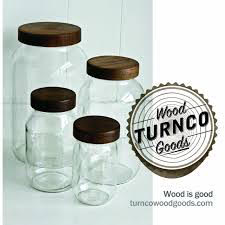 Handmade wooden items for the kitchen, including wood lids for glass jars, rolling pins, serving pieces and more. “We are a small batch manufacturing company, producing beautiful and functional pieces crafted for home use. A lot of thought goes into the style, quality and functionality of each product we make. It comes from our experience in working on custom projects, as well as honing our skills of efficiency and organization in making value added wood goods. All of our goods have a mix of simple modern design and warm nostalgia. When possible we use FSC certified lumber, and local hardwood like Madrona, Rock Elm, Big Leaf Maple and softwoods like western Red Cedar, Douglas Fir from our local lumberjack contacts here on Whidby Island.”
Handmade wooden items for the kitchen, including wood lids for glass jars, rolling pins, serving pieces and more. “We are a small batch manufacturing company, producing beautiful and functional pieces crafted for home use. A lot of thought goes into the style, quality and functionality of each product we make. It comes from our experience in working on custom projects, as well as honing our skills of efficiency and organization in making value added wood goods. All of our goods have a mix of simple modern design and warm nostalgia. When possible we use FSC certified lumber, and local hardwood like Madrona, Rock Elm, Big Leaf Maple and softwoods like western Red Cedar, Douglas Fir from our local lumberjack contacts here on Whidby Island.”
Terrasoul Superfoods
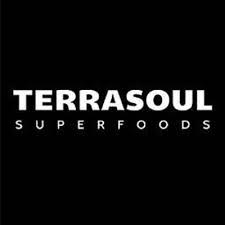 Certified organic raw superfoods from around the world, including cacao and vanilla, coconut, dried fruits and berries and their powders, grass juice powder, nutritional powders, nuts and seeds, seaweed and algae. “We are a small, family-run business located in Fort Worth, Texas. Terrasoul Superfoods was born out of our desire to find reliable and affordable sources of certified organic, fair trade, and sustainably-grown, nutrient-dense foods….We sell the foods we know and love.”
Certified organic raw superfoods from around the world, including cacao and vanilla, coconut, dried fruits and berries and their powders, grass juice powder, nutritional powders, nuts and seeds, seaweed and algae. “We are a small, family-run business located in Fort Worth, Texas. Terrasoul Superfoods was born out of our desire to find reliable and affordable sources of certified organic, fair trade, and sustainably-grown, nutrient-dense foods….We sell the foods we know and love.”
Furniture in the Raw
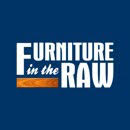 All wood furniture for every room in your home. “We offer customers finished, unfinished, and custom finished all wood furniture. We only sell furniture made with real wood that is particle board free.”
All wood furniture for every room in your home. “We offer customers finished, unfinished, and custom finished all wood furniture. We only sell furniture made with real wood that is particle board free.”
Willa Walker
 This is a simple yet smart tool that makes learning to walk even more fun for toddlers while saving adults the back-pain from always having to bend over to help them. It consists of a wooden handle, two ropes and two wooden rings.”WWs are made by 4 dads from 100% recycled, sustainably-farmed wood, cotton & coconut oil. Thats it! The child’s safety has always been our first priority when designing the WW. For this reason, we have chosen only high quality, traceable, non-toxic, materials for each component of the WW. Much detail and attention has been provided within the Instructions for Use. The Willa Walker meets Consumer Products Safety Commission (CPSC) safety standards.”
This is a simple yet smart tool that makes learning to walk even more fun for toddlers while saving adults the back-pain from always having to bend over to help them. It consists of a wooden handle, two ropes and two wooden rings.”WWs are made by 4 dads from 100% recycled, sustainably-farmed wood, cotton & coconut oil. Thats it! The child’s safety has always been our first priority when designing the WW. For this reason, we have chosen only high quality, traceable, non-toxic, materials for each component of the WW. Much detail and attention has been provided within the Instructions for Use. The Willa Walker meets Consumer Products Safety Commission (CPSC) safety standards.”
Asbestos Awareness
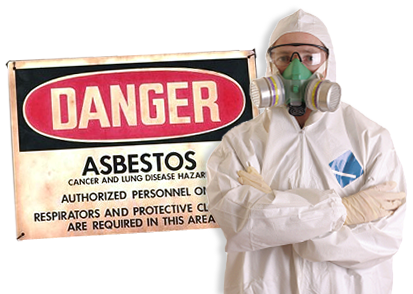
A reader alerted me to the fact that this week is Asbestos Awareness Week.
I haven’t written much about asbestos because I thought it was banned. In fact, on 12 July 1989, the EPA issued a final regulation banning most uses of asbestos, but not all. But the asbestos industry filed a lawsuit against the EPA and overturned the ban. Read more about the ban and current restrictions
Then Mesothelioma + Asbestos Awareness Center wants to see a future where a highly preventable cancer is virtually non-existent because people are more aware as to where the hazardous material can be found in their homes and occupations. They also provide information for those who are interested in learning more about the cancer as they themselves are experiencing it, or are students learning about other lung diseases as they enter health and medical fields.
While asbestos is not as widely used today as it was in the past, it is still found in some consumer products. Shannon also sent me an article about five products that still contain asbestos: car parts, insulation, construction materials, fireproof clothing, and potting soils. Potting soils? It’s the vermiculite in potting soils that may be contaminated with asbestos, as they occur in nature together.
Other domestic products that may contain asbestos include:
- Crock pot linings and around the power cord: especially those manufactured prior to 1980
- Ironing board covers either made with asbestos cloth or had asbestos fibers weaved into the material: those commonly sold around the 1960
- Hair dryer heating elements: those produced prior to 1979, though there is a possibility of foreign-made hair dryers still containing some amount of asbestos
And if you are looking for or living in an older home to avoid outgassing of VOCs from modern building materials, those older homes are the most likely to contain asbestos. Within those homes asbestos can be found in roofing tiles, vinyl flooring (installed prior to 1980), popcorn ceiling, piping, and wall boards.
Here’s another post on this blog about asbestos: Q&A: My Personal Experience with “Second -Hand” Asbestos.
Is There a Safe Wallpaper?
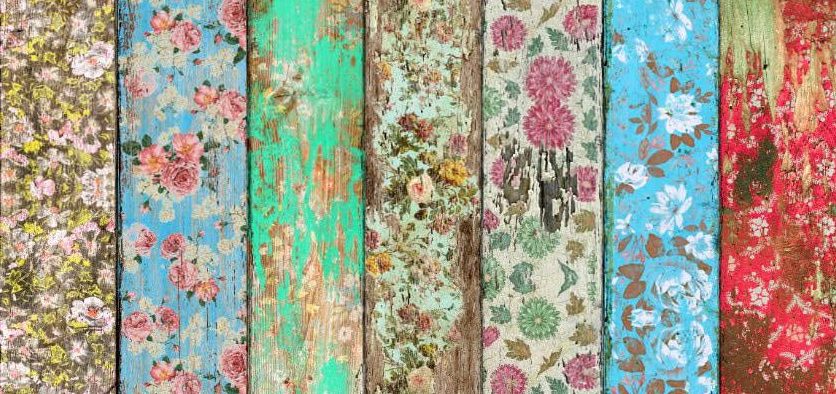
Question from Eliana
Hi Debra,
I am thinking of having wallpaper in my dining room. The selection of non-vinyl wallpaper is very slim. I am very green and keep indoor air as clean as I can. The question is, does vinyl off gas forever? The other question is, what about the glue they use to put it up. Is it sealed once the wallpaper is on and if not does it off gas forever?
It is so challenging to stay green in the world we live in.
Please let me know?
Thanks so much.
Debra’s Answer
Soft vinyl outgassed forever, to a lesser and lesser degree as time goes by. I really recommend no using vinyl wallpaper.
In addition, if you use air conditioning, mold can grow behind wallpaper which is a vapor barrier stopping hot and moist exterior air entering walls in summer.
Over the years I’ve seen a few uncoated paper wallpapers, but personally, if you want a pattern on the walls, I would stencil or hand paint the pattern with a nontoxic paint rather than try to deal with a paper wallpaper. I’m concerned it may mold.
Here is a very good list of the many different types of wallpapers, showing the materials—both synthetic and natural—used to make them:
Wallpaper Types, Textures, And Their Different Applications
And here is a resource about wallpaper adhesives:
Wallpaper Adhesives
The choices for paste seems to be vinyl, wheat, or cellulose.
So it IS possible to find a natural wallpaper and a natural paste, but I am concerned about mold, especially in a humid environment.
Chlordane Alert
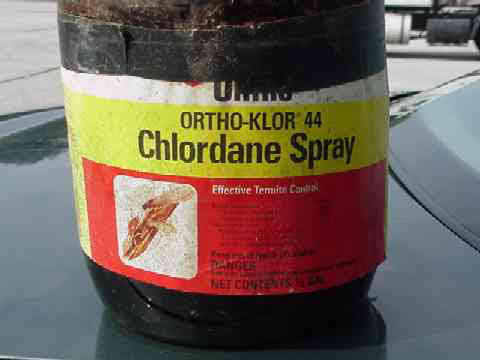
Question from Magda
Dear Debra,
Originally I thought that chlordane would not be a problem in and around houses any more. Until I came upon the study, article, and description of practices excerpted below.
Sorry to bring up such a long, unpleasant litany, now that spring is here and the daffodils are blooming!
But I live in Iowa and love gardening. It is very hard not to weed close to house walls, where a potential contmination would be worst, and has possibly been spread around through the building of porches, digging near foundations etc.
Do you know of any chlordane test except the one offered by Dr. Richard A. Cassidy of Toxfree, who also put the mentioned practices described below on the internet?
Thank you very much in advance. Thank you also for helping us ordinary people (who do not know science) live healthier lives.
Magda
STUDY
Health Dangers of Chlordane
by Dr. Edward Group DC, NP, DACBN, DCBCN, DABFM
[schema] published + updated Published on March 14, 2013, Last Updated on May 28, 2013
The University of Iowa examined soil samples and discovered that Cedar Rapids Iowa had chlordane soil contamination almost as severe as urban areas of China.
References
References:
Hedley AJ, Hui LL, Kypke K, Malisch R, van Leeuwen FX, Moy G, Wong TW, Nelson EA. Residues of persistent organic pollutants (POPs) in human milk in Hong Kong. Chemosphere. 2010 Apr;79(3):259-65. doi: 10.1016/j.chemosphere.2010.01.047. Epub 2010 Mar 2.
Bao LJ, Maruya KA, Snyder SA, Zeng EY. China’s water pollution by persistent organic pollutants. Environ Pollut. 2012 Apr;163:100-8. doi: 10.1016/j.envpol.2011.12.022. Epub 2012 Jan 11. Review.
Martinez A, Erdman NR, Rodenburg ZL, Eastling PM, Hornbuckle KC. Spatial distribution of chlordanes and PCB congeners in soil in Cedar Rapids, Iowa, USA. Environ Pollut. 2012 Feb;161:222-8. doi: 10.1016/j.envpol.2011.10.028. Epub 2011 Nov 26.
Mast MA, Alvarez DA, Zaugg SD. Deposition and accumulation of airborne organic contaminants in Yosemite National Park, California. Environ Toxicol Chem. 2012 Mar;31(3):524-33. doi: 10.1002/etc.1727. Epub 2012 Feb 6.
Morrissey CA, Pollet IL, Ormerod SJ, Elliott JE. American dippers indicate contaminant biotransport by Pacific salmon. Environ Sci Technol. 2012 Jan 17;46(2):1153-62. doi: 10.1021/es2028058. Epub 2011 Dec 23.
Lopez J, Boyd D, Ylitalo GM, Littnan C, Pearce R. Persistent organic pollutants in the endangered Hawaiian monk seal (Monachus schauinslandi) from the main Hawaiian Islands. Mar Pollut Bull. 2012 Nov;64(11):2588-98. doi: 10.1016/j.marpolbul.2012.07.012. Epub 2012 Aug 9.
Everett CJ, Matheson EM. Biomarkers of pesticide exposure and diabetes in the 1999-2004 national health and nutrition examination survey. Environ Int. 2010 May;36(4):398-401. doi: 10.1016/j.envint.2010.02.010. Epub 2010 Mar 17.
Goldner WS, Sandler DP, Yu F, Hoppin JA, Kamel F, Levan TD. Pesticide use and thyroid disease among women in the Agricultural Health Study. Am J Epidemiol. 2010 Feb 15;171(4):455-64. doi: 10.1093/aje/kwp404. Epub 2010 Jan 8.
Vogt R, Bennett D, Cassady D, Frost J, Ritz B, Hertz-Picciotto I. Cancer and non-cancer health effects from food contaminant exposures for children and adults in California: a risk assessment. Environ Health. 2012 Nov 9;11:83. doi: 10.1186/1476-069X-11-83.
Sakamoto K, Nishizawa H, Manabe N. Behavior of pesticides in coffee beans during the roasting process. Shokuhin Eiseigaku Zasshi. 2012;53(5):233-6.
ARTICLE
Environ Pollut. 2012 Feb;161:222-8. doi: 10.1016/j.envpol.2011.10.028. Epub 2011 Nov 26.
Spatial distribution of chlordanes and PCB congeners in soil in Cedar Rapids, Iowa, USA.
Martinez A1, Erdman NR, Rodenburg ZL, Eastling PM, Hornbuckle KC.
Author information
Department of Civil & Environmental Engineering, IIHR-Hydroscience and Engineering, The University of Iowa, 4105 SC, Iowa City, IA 52242, USA.
Residential soils from Cedar Rapids, Iowa, USA were collected and analyzed for chlordanes and polychlorinated biphenyls (PCBs). This study is one of the very few urban soil investigations in the USA. The chlordanes concentrations ranged from 0 to 7500 ng g(-1) dry weight (d.w.), with a mean and standard deviation of 130 ± 920 ng g(-1) d.w., which is about 1000 times larger than background levels. ΣPCB concentrations ranged from 3 to 1200 ng g(-1) d.w., with a mean and standard deviation of 56 ± 160 ng g(-1) d.w. and are about 10 times higher than world-wide background levels. Both groups exhibit considerable variability in chemical patterns and site-to-site concentrations. Although no measurements of dioxins were carried out, the potential toxicity due to the 12 dioxin-like PCBs found in the soil is in the same order of magnitude of the provisional threshold recommended by USEPA to perform soil remediation.
Copyright © 2011 Elsevier Ltd. All rights reserved.
PRACTICES
Information provided by
Richard W. Pressinger (M.Ed.), Wayne Sinclair, M.D.
How to Correct Chlordane Home Contamination
Application to Outside Wood Surfaces
Chlordane was frequently applied to the outside wood surfaces of many homes built before 1988. This would have been done because of an actual termite problem or as a preventive safeguard from a worried homeowner. Under first consideration, the application to the outside of the home would not appear as a problem, however, as described in research on the chlordane web site, conducted by Dr. Kaye Kilburn of the the University of California, even outdoor applications of the chemical can find their way indoors to contaminate the interior to a level that can cause a variety of health problems from increased infections to increases in many neurological disorders including – anger, migraine headaches and depression.
Correction Procedure
The least expensive way to correct contamination of the exterior wood surfaces of a home is to seal the wood with a hard, enamel based paint. The most efficient method for correcting this problem is to identify which side of the home the problem exists and to then replace the contaminated wood pieces. If the home is constructed of 4×8 sheets of plywood siding, these sheets can be easily replaced for a materials cost of about $25.00 per sheet. Check with the pest control company who applied the chlordane and ask if their records show where chlordane was applied.
Infiltration up through the Foundation of the Home
This is the same route that radon has been found to contaminate homes throughout the U.S. When a home was built before 1988, standard procedure was to literally saturate 100 gallons of chlordane into the soil per 1000 square feet of home area just before the concrete foundation was poured. Therefore, a 2000 square foot home would have 200 gallons of chlordane saturated into the soil. After several years of “settling,” cracks form in the foundation and basement walls or around plumbing pipes which has been found to allow for entry of the chemical into the home.
Correction Procedure
Success has been shown with underground infiltration problems by simply identifying where the cracks in the foundation are located and sealing these with an acrylic caulking or similar compound. It is also recommended to caulk around all plumbing pipe entry points through the foundation. As chlordane was often concentrated in the outer one or two foot perimeter just underneath the foundation, there needs to be a good caulking seal at the point where the wall meets the floor
Attic Contamination
As the attic of a home is comprised of wooden 2×4 support beams, these were often sprayed with chlordane by a pesticide company to ward off future termite problems. Unfortunately, when the applicator is spraying the beams, the chemical can easily drip onto the ceiling drywall sheets that were nailed to the 2×4’s. Drywall is made of rock powders that act like a sponge, quickly absorbing the chemical and then outgas the chlordane into the living area below. Contamination would then occur to the area below which could be either the kitchen, living room or bedroom.
Correction Procedure
Ceiling drywall that has soaked up chlordane due to an attic application of chlordane can be widespread. Ceiling drywall can be purchased inexpensively in 3/8 inch thicknesses for around $5.00 for a 4×8 foot sheet. It is recommended that these be placed over existing ceiling drywall or to completely remove the existing drywall and to then apply new drywall.
Accidental Spills
The research has documented spills of chlordane containers occurring during testing research and has certainly happened to an unknown percentage of homes built before 1988. The spills could range from a few ounces to one gallon or 55 gallon containers. If one room registers a much higher chlordane level than another room – the possibility of a chlordane spill should be considered.
Correction Procedure
If a significant amount of chlordane has been spilled onto any inside flooring the two correction procedures in order of effectiveness include – painting the floor with an enamel based paint or laying ceramic or hard vinyl tile over the contaminated area.
Normal Application Residue
Although chlordane was routinely used outside the home up through March of 1988, it was often used for the indoor control of roaches and ants up until 1981. Chlordane was easily purchased by homeowners from department stores before this date as an effective roach and ant pesticide. Indoor areas routinely treated with chlordane include underneath the kitchen sink, behind the refrigerator, behind the dishwasher and along baseboards throughout the bedrooms. Sometimes the chemical odor of chlordane underneath a kitchen sink is “overwhelming” due to this area receiving repeated chlordane applications. Chlordane contamination still occurs today as many “garden/tool sheds” still have bottles of outdated chlordane on the shelves.
Correction Procedure
If contamination under the kitchen sink is suspected, perform a chlordane air test underneath the sink. High levels found here can be “sealed in” using new plywood or if air chlordane contamination is exceptionally high, the homeowner may be better off replacing the old counter top with a new one. Baseboards along the floor can be sealed with an enamel paint or can be replaced at a cost of 30 cents to $1.00 per foot.
Debra’s Answer
Thank you for all this information Magda. Chlordane is a very toxic pesticide and it’s important to know it’s still a hazard to watch out for.






